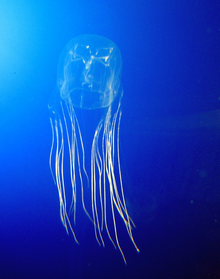Sean loves writing blog posts about the differences between living in the U.S. and living in Australia. The theme of our A-Z Challenge this year was Australia and all the cool places to visit there. I love these posts too because it is fun to compare and contrast the cultures, lifestyles, stores, language, etc. Last year, he blogged about some pretty deadly Australian sea life that we do not have in the waters off our coasts. Enjoy!
------------------------------------------------------------------------------------------------------------
It is pretty well known that Australia is home to some of the most unique animals in the world. It is also home to many of the deadliest animals as well. It sometimes seems that if you watch a nature program on TV you sometimes think that the country is just crawling with them and its only a matter of seconds before something bites or devours you. The truth is that although many of Australia's animals are quite deadly they are normally afraid of humans and you have to do something pretty silly to get attacked.
Today's post looks to the coastline of Australia and will highlight some of the nasties that could await you in the water. We will skip the sharks for now even though they do earn an honourable mention, but there are not very many unique species of sharks that live exclusively around Australia that are known to attack humans. Below are a few of Australia's marine creatures that are best avoided and left well alone.
| Source |
Box Jellyfish: These guys are next to invisible in the water and can provide a sting that is more painful than anything you have ever felt. Found in the tropical waters of northern Australia they are so dangerous many beaches are closed to swimmers during the Australian summer. It is one of the larger jellyfish and the bell can be as large as a man's head and the stingers can trail for several feet. Even when dead jellyfish or detached stingers can provide a painful sting. The venom is deadly and has been responsible for the deaths of at least 80 people in the last 150 years. If stung the recommended remedy is to flood the sting area with vinegar as it helps detaches the stingers from the skin and to seek medical attention. Its definitely best to check with the locals or heed the warning signs before heading into the waters in the tropical areas of Australia.
Stonefish: Thankfully these guys are rare but they can deliver a nasty surprise to anyone unlucky enough to step on one. Found along the coast of the top half of Australia, Stonefish are found partially buried in the sand. They do this to camouflage themselves from their prey but sadly this makes them impossible to see. They often will not move even if someone is about to step on them so it is recommended to wear good water shoes and tread carefully. The danger comes from a row of venomous spines that run along the top of the fish that is activated when someone steps on the fish. Although it is not as deadly as some of the other creatures around Australia's coastline these guys will do a number on the bottom of your foot and will make walking quite painful for many days. If you happen to step on one it is recommended to sooth the pain with hot water and to seek medical attention.
These are just some of the dangers along the coastline of Australia. Although they are out there most visitors to Australian beaches never encounter any of these creatures. I did see a Blue Ringed Octopus in a rock pool when I was fairly young and a dead Box jellyfish a few years later but knew enough to steer clear of them. As long as you take the proper precautions you should have an safe and fun time.
-------------------------------------------------------------------------------------------------------------
Pretty crazy, huh? Which one do you think is the craziest/weirdest/most interesting? For me it is definitely the stone fish. That little guy seems intense!
Happy Thursday,




I would love to see the octopus myself! All interesting. I was never one that enjoyed going into the ocean though lived by the beach the majority of my life. Creatures like this dissuaded me from doing so, though I think the worst we had in San Diego were jellyfish.
ReplyDeletebetty
how scary! are there hospitals near the beaches where you can find blue ringed octopuses?
ReplyDeleteWhen we were in Cairns, my daughter rubbed up against some coral and it left similar markings to a jellyfish. The lifeguard grabbed her arm and poured vinegar on it. When she screamed and pulled back he was relieved that it wasn't the box jellies. The octopus above is new to me. Interesting that it is an almost painless bite.
ReplyDelete